Rupin Pass Trek: Unleash the Thrill of the Himalayas
- Trekking Destinations
-
Jun 29
- Share post
Welcome to the breathtaking world of the Rupin Pass Trek, an exhilarating adventure that takes you through the stunning landscapes of the Himalayas.
This high altitude trek is a true gem for adventure enthusiasts, offering a perfect blend of natural beauty, adrenaline-pumping challenges, and a sense of accomplishment.
In this article, we will cover all the details, covering the trekking itinerary, the best season to do the trek, budget & cost, how to reach the starting point, highlights of the trek and FAQs for a successful expedition.
- Max Altitude: 15,250 Ft. (4,650M)
- Average Trekking Fees: ₹14,000 – ₹16,000
- Distance: 37 – 45 kms
- Difficulty: Moderate-Difficult
- Duration: 7 days
- Ideal For: Experienced Trekkers Only
- Best Season: Mid April – June & September - Mid November
- Region: Himachal Pradesh
Table of Contents
ToggleRupin Pass Trek: An Overview
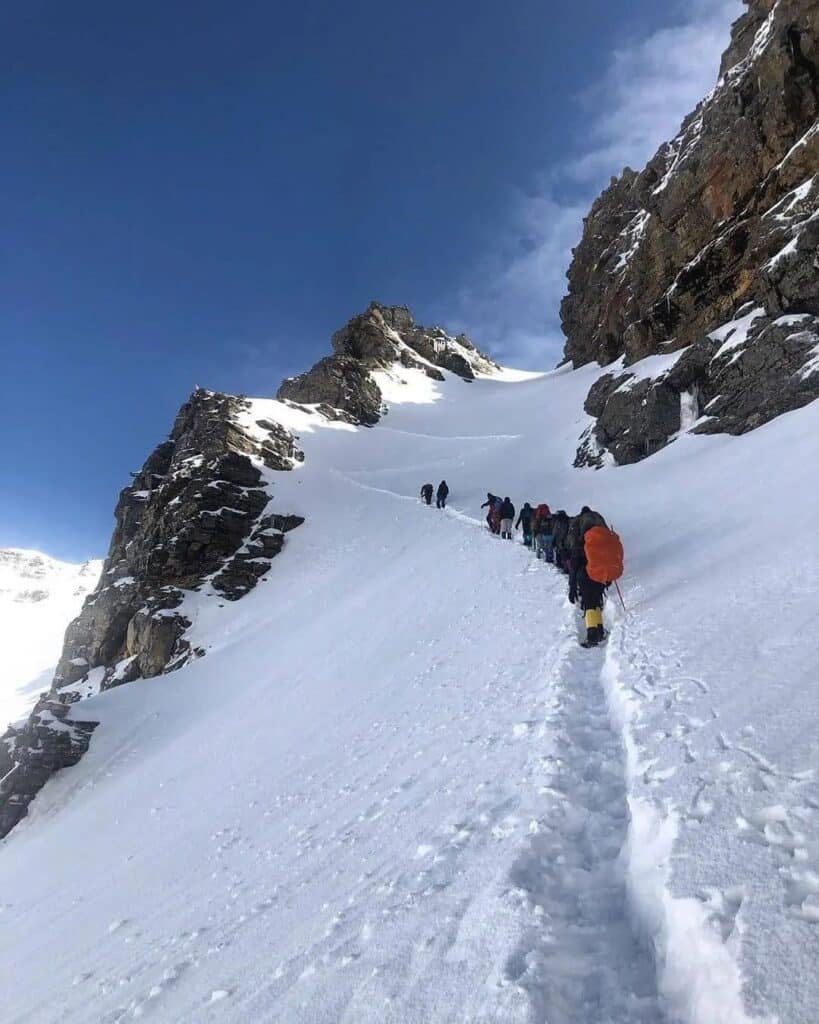
The trek is a thrilling and picturesque adventure in Himachal Pradesh. It takes you through a diverse and stunning landscape, showcasing the raw beauty of the mountains. The trek starts from the village of Jiskun and concludes in Sangla, Himachal Pradesh.
The journey begins with gentle ascents through charming villages, terraced fields, and dense forests of oak, rhododendron, and pine. As you gain altitude, the scenery transforms into breathtaking alpine meadows, cascading waterfalls, and glacial valleys. One of the trek’s highlights is the mesmerizing Rupin Waterfall, a magnificent sight.
The trail becomes more challenging as you approach the Rupin Pass, situated at around 15,250 feet (4,650 meters). The final ascent involves negotiating steep slopes, boulders, and snow patches. However, the efforts are rewarded with awe-inspiring panoramic views of the mountains, including the majestic Kinner Kailash range.
The descent from the Pass leads to the Sangla Valley, known for its apple orchards and traditional Himachali villages. The trek ends in Sangla, where you can immerse yourself in the local culture and relish the scenic beauty.
The Rupin Pass trek is moderately difficult, requiring good physical fitness and prior trekking experience. It is perfect for adventure enthusiasts seeking a thrilling and rewarding experience amidst the pristine Himalayan wilderness.
Additional Information for the Rupin Pass Trek

Trekking Difficulty & Duration
The trek is considered moderately difficult and suitable for experienced trekkers. It involves traversing challenging terrains, steep ascents, and negotiating boulders and snow patches. Prior trekking experience and good physical fitness are recommended to fully enjoy and successfully complete the trek.
The trek typically ranges from 7 to 8 days, depending on the itinerary and the pace of the trekking group. The trek covers a distance of approximately 37 – 45 kilometres from Jiskun in Uttarakhand to Sangla in Himachal Pradesh.
Each day, trekkers cover an average distance of 5 to 10 kilometres (3 to 6 miles), with varying levels of ascent and descent. The duration of each day’s trek can range from 5 to 8 hours, depending on the fitness level of the trekkers and the prevailing weather conditions.
It’s important to note that the trek involves camping in remote locations with basic facilities and limited access to amenities. Trekkers must be prepared for variable weather conditions, including cold temperatures and possible rain or snowfall.
Overall, the trek offers a challenging yet immensely rewarding experience for adventure enthusiasts, allowing them to immerse themselves in the stunning landscapes and natural beauty of the Indian Himalayas.
Best Time For the Rupin Pass Trek
The trek is best undertaken during two distinct seasons: Mid-April to June (Summer) and September to Mid-November (Autumn). Both seasons offer unique experiences and stunning landscapes, catering to different preferences.
During the summer, from mid-April to June, the trek is characterized by pleasant weather, blooming rhododendrons, and vibrant meadows. The trail is adorned with colourful flowers and lush greenery, creating a picturesque setting. The temperatures during this time range from mild to moderately cold, with daytime temperatures averaging around 10 to 15 degrees Celsius. However, it’s important to note that occasional rainfall can be expected during the summer months, so proper rain gear is essential. The summer season is ideal for those who enjoy the sight of vibrant flora, comfortable trekking conditions, and moderate temperatures.
On the other hand, the autumn season, from September to mid-November, offers a completely different charm. The weather becomes cooler, and the landscapes transition into hues of gold and orange as the leaves change colour. The autumn season is known for its clear skies, providing breathtaking views of the surrounding peaks. The temperatures can vary significantly, with daytime temperatures ranging from 5 to 15 degrees Celsius. Autumn is a great time for trekkers who prefer cooler temperatures, clearer views, and a quieter experience.
Both seasons have their own allure and advantages, and their choice depends on personal preferences. Whether you prefer the vibrant summer blooms or the crisp beauty of autumn, the trek promises a memorable adventure amidst the awe-inspiring Himalayan landscapes.
Budget & Costing for the trek
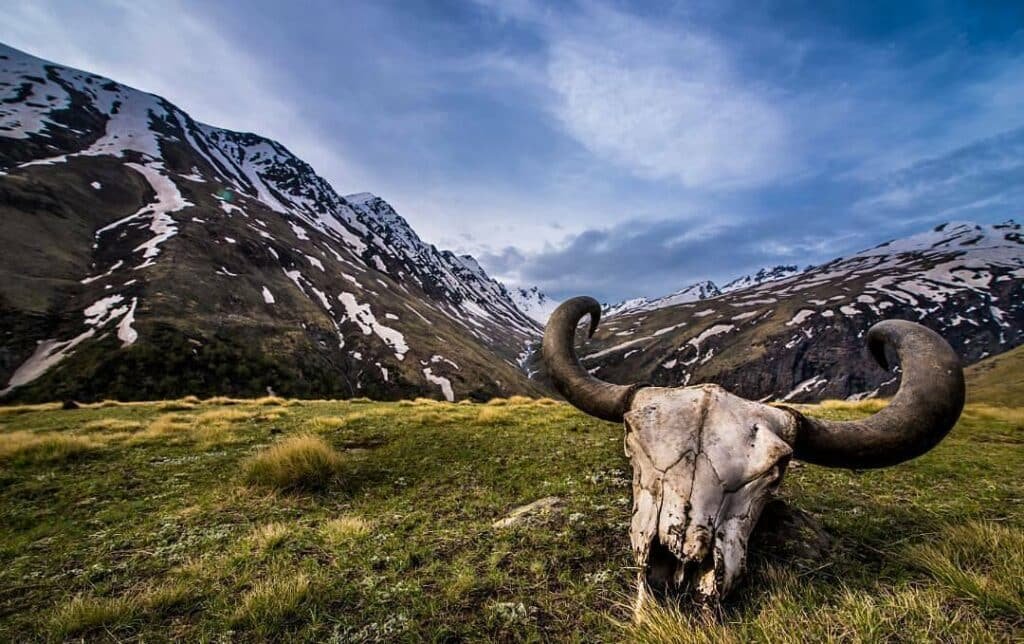
The budget and cost for the trek can vary depending on several factors, such as the type of accommodation, mode of transportation, food preferences, and personal expenses. Here’s a breakdown of the average expenses involved:
- Trekking Fees: The average trekking fees charged by organizations for the trek typically range from ₹ 14,000 to ₹ 16,000. This fee usually includes services such as experienced guides, camping equipment, meals, and permits.
- Transportation: The cost of transportation to reach the starting point of the trek, Jiskun, needs to be considered. This can include expenses for flights or buses/trains to Delhi or Chandigarh and further transportation to Jiskun via Shimla. The budget for transportation can vary depending on the mode of travel and distance covered.
- Accommodation: During the trek, accommodation is mostly in tents or basic guest houses in villages along the route. The cost of accommodation is generally included in the trekking fees.
- Food and Water: Most trekking packages include meals during the trek. However, if you prefer to carry your own food or have dietary restrictions, it is advisable to budget for additional food expenses. Similarly, budgeting for packaged drinking water or water purification methods is essential.
- Equipment and Gear: If you do not have trekking equipment, you may need to rent or purchase gear such as trekking shoes, backpacks, sleeping bags, and jackets. Consider these costs if required.
- Miscellaneous Expenses: It is recommended to keep some extra funds for unforeseen expenses, snacks, personal medication, and tips for the trekking staff.
Remember, the trek budget can vary based on individual preferences and requirements. Researching and comparing prices from different organizations and planning accordingly to ensure a comfortable and enjoyable trekking experience is advisable.
How To Reach?
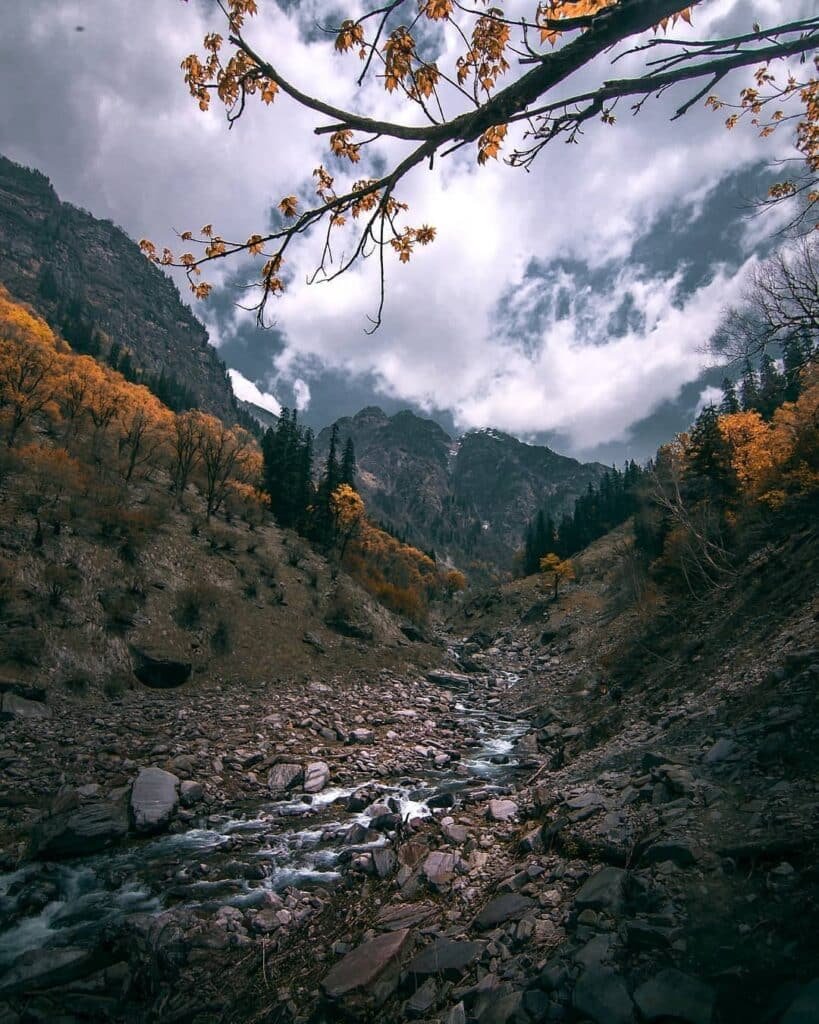
To reach the start point of the trek, which is Jiskun, you can consider the following transportation options:
- Flights: The nearest airports to Jiskun are Delhi and Chandigarh. You can book a flight to Delhi’s Indira Gandhi International Airport (DEL) or Chandigarh’s Chandigarh International Airport (IXC). From there, you can take a taxi or bus to reach Shimla, which is approximately 190 kilometres away from Jiskun. Flights to Delhi or Chandigarh can be accessed from various cities within India and internationally.
- Local Buses: From Shimla, you can take a local bus to Jiskun. Shimla is well-connected by road, and regular buses ply between Shimla and other major towns and cities in the region. You can check the timings & availability of the buses from the Shimla Bus Stand or inquire at local transportation offices.
- Trains: You can train to Kalka Railway Station in Haryana if you prefer train travel. You can board the famous UNESCO World Heritage Kalka-Shimla toy train from Kalka, which offers a scenic journey to Shimla. Once in Shimla, you can proceed to Jiskun by local bus or taxi.
Upon reaching Shimla, arranging transportation to Jiskun in advance is advisable, either by booking a private taxi or checking for shared cabs or buses. Consider the travel time and road conditions while planning your journey to reach the start point of the trek.
Detailed Itinerary for the Rupin Pass Trek
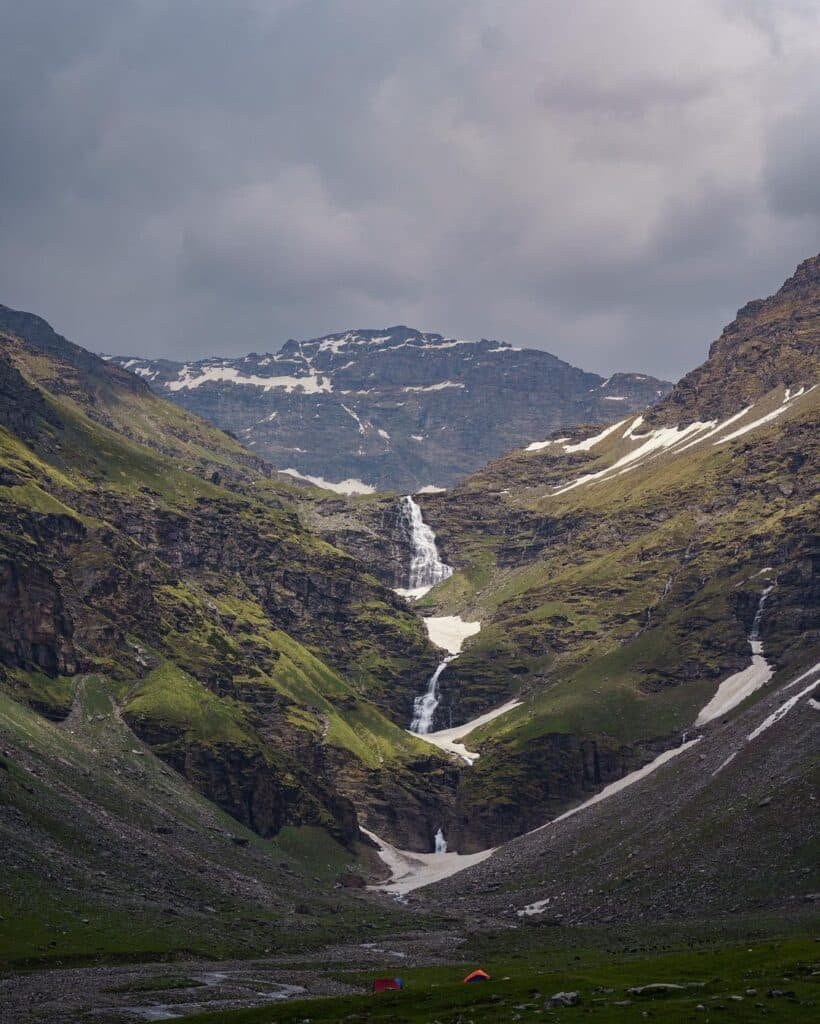
Day 1: Bawta Village to Jhaka (5 kilometres, approximately 5-6 hours)
The trek begins from Bawta village, and the trail takes you through scenic landscapes and charming villages. The trek to Jhaka, also known as Dhaula, is relatively easy and covers a distance of 8 kilometres. It will take around 5 to 6 hours to reach Jhaka, where you will camp for the night.
Day 2: Jhaka to Saruwas Thatch (8 kilometres, approximately 6-7 hours)
In today’s leg of the trek, trekkers descend towards the Rupin river, enjoying the mesmerizing sight of its crystal-clear blue waters. The landscape transitions from dense fir forests to occasional snowy patches. Crossing a snow bridge and a wooden bridge, one must carefully navigate boulders and streams, immersing ourselves in the enchanting beauty of a diverse rhododendron-filled forest.
Day 3: Saruwas Thatch to Dhanderas Thatch (3 kilometres, approximately 2-3 hours).
On this day, the trail gradually ascends to Dhanderas Thatch, passing through vast meadows and crossing a river. The distance covered is around 7 kilometres, taking approximately 4 to 5 hours. Camp overnight at Dhanderas Thatch.
Day 4: Dhanderas Thatch to Upper Waterfall Camp (5 kilometres, approximately 3-4 hours)
The trek from Dhanderas Thatch to Upper Waterfall Camp is shorter but involves steep ascents. You’ll witness the majestic Rupin Waterfall along the way. The distance covered is around 6 kilometres, taking approximately 3 to 4 hours. Camp overnight at Upper Waterfall Camp.
Day 5: Upper Waterfall Camp to Rupin Pass to Ronti Gad (10 kilometres, approximately 8-10 hours).
This is the most challenging and rewarding day of the trek. You’ll ascend to the Rupin Pass at approximately 15,250 feet (4,650 meters). The trek covers a distance of 14 kilometres and takes around 8 to 10 hours. Enjoy breathtaking panoramic views from the pass and descend to Ronti Gad for overnight camping.
Day 6: Ronti Gad to Sangla (12 kilometres, approximately 5-6 hours).
The final day involves a descent through beautiful forests and scenic landscapes. The trek covers a distance of 12 kilometres, taking approximately 5 to 6 hours. Reach Sangla, where the trek concludes, and bid farewell to the stunning Himalayan region.
Please Note: This is a general itinerary, followed by most of the trekking groups in India. However, there might be slight differences in the itinerary depending on the trekking group you opt to go with.
Highlights of the Rupin Pass Trek
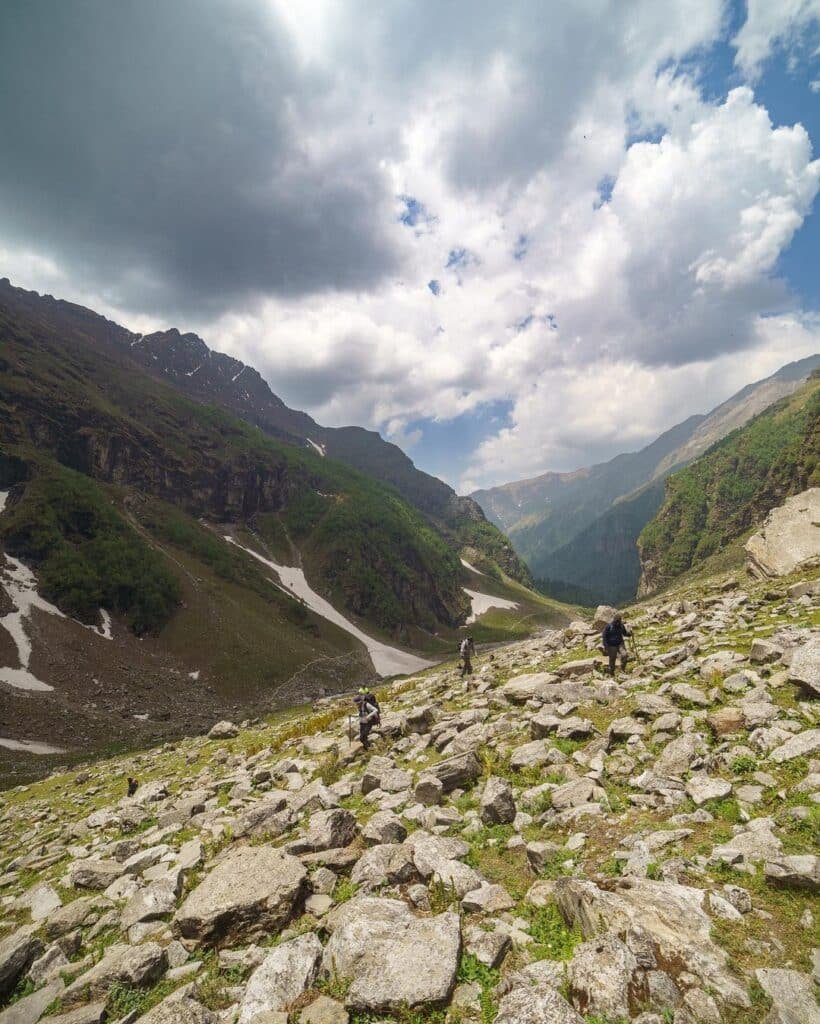
Breathtaking Scenic Landscapes
Be mesmerized by the stunning scenic landscapes at every step. The trek offers a diverse and breathtaking visual feast, from snow-capped mountains to lush green meadows, cascading waterfalls, and dense forests.
Challenging Terrain and Thrilling Crossings
Prepare yourself for an exhilarating adventure as you navigate through challenging terrains. The trek involves crossing snow bridges, wooden bridges, boulders, and streams, adding a thrilling element to the journey. Each crossing brings a sense of accomplishment and excitement.
Rupin Waterfall – Nature’s Majestic Spectacle
One of the standout features of the trek is the magnificent Rupin Waterfall. Witness the awe-inspiring sight of water cascading down from great heights, surrounded by the pristine beauty of the Himalayas. The grandeur of the waterfall leaves trekkers in awe and creates unforgettable memories.
Rich Biodiversity and Flora
Experience the vibrant biodiversity of the region as you trek through forests adorned with a wide variety of flora. The trek is particularly famous for its vibrant rhododendron forests, which explode with colours during the blooming season, creating a picturesque landscape.
Spectacular Summit at Rupin Pass
Reach the pinnacle of the Rupin Pass and get awarded with breathtaking panoramic views of the surrounding peaks and valleys. The summit is approximately 15,250 feet, offering a sense of accomplishment and a truly unique vantage point.
Cultural Immersion in Remote Villages
Along the trekking route, encounter the warm hospitality of the remote villages in the Himalayas. Interact with locals, experience their unique culture, and gain insights into their way of life, adding a cultural dimension to your trekking adventure.
The trek encapsulates the essence of an exhilarating and awe-inspiring Himalayan adventure, leaving trekkers with memories that will last a lifetime.
Essential Gear and Equipment
Before embarking on the trek, it is essential to pack the right gear and equipment to ensure a safe and comfortable journey. Here is a list of items you should consider carrying:
- Trekking shoes with good ankle support
- 45L trekking Rucksack with rain cover
- Trekking gaiters
- Warm and waterproof clothing layers
- Sleeping bag suitable for sub-zero temperatures
- Trekking poles for better stability on uneven terrains
- UV-protected sunglasses and sunscreen
- Water bottles and water purification tablets
- Headlamp or flashlight with extra batteries
- First aid kit with essential medications
- Portable power bank for charging electronic devices
Safety Tips & Precautions
While embarking on any trek, safety should always be a top priority. Here are some essential safety tips to keep in mind during the Sar Pass Trek:
- Trek with experienced trek leaders and follow their instructions.
- Stay hydrated and carry an adequate supply of water.
- Pack light and carry only the essential items.
- Dress in layers to adapt to changing weather conditions.
- Respect the environment and maintain cleanliness.
- Inform someone about your trekking plans and expected return.
- Stay updated about weather conditions and local regulations.
- Avoid alcohol and smoking during the trek.
- Make sure if you are doing it on your own to carry emergency oxygen cylinders.
Conclusion
Embark on the Rupin Pass trek and discover an unforgettable adventure through breathtaking landscapes. Each step unveils nature’s splendour, from snow-capped peaks to vibrant rhododendron forests.
Traverse challenging terrains, cross mesmerizing rivers, and witness the majesty of the Rupin Waterfall. Reach the summit of the Rupin Pass, where panoramic views reward your efforts.
Immerse yourself in the awe-inspiring beauty of the Indian Himalayas, forging memories to last a lifetime. The Rupin Pass trek is an experience that will leave you in awe of nature’s wonders.
FAQs
Rupin Pass trek is considered moderately difficult, suitable for experienced trekkers.
Rupin Pass is famous for its stunning natural beauty, picturesque landscapes, and the thrilling adventure it offers to trekkers.
Rupin Pass trek is a multi-day Himalayan adventure that takes you through remote villages, lush forests, snow-capped peaks, and a challenging high-altitude mountain pass.
Rupin Pass trek is not recommended for beginners. It requires prior trekking experience and good physical fitness due to its challenging terrain and steep ascents.
Video of the Rupin Pass Trek
Did you like this trek guide for the Rupin Pass trek?
We have 100s more such guides on similar off-beat experiences & we send out such guides, offers, hidden gems, and trekking destinations weekly via email. Subscribe to our newsletter to get them directly into your inbox.
Comments
Add a comment
Leave a Reply · Cancel reply
This site uses Akismet to reduce spam. Learn how your comment data is processed.
